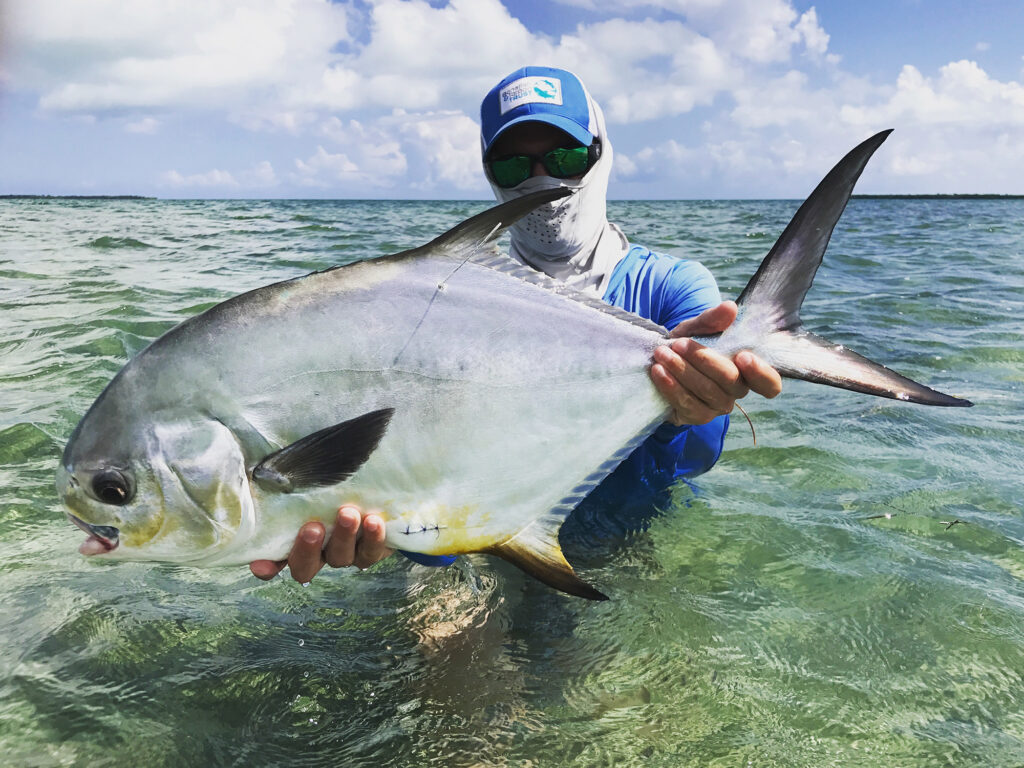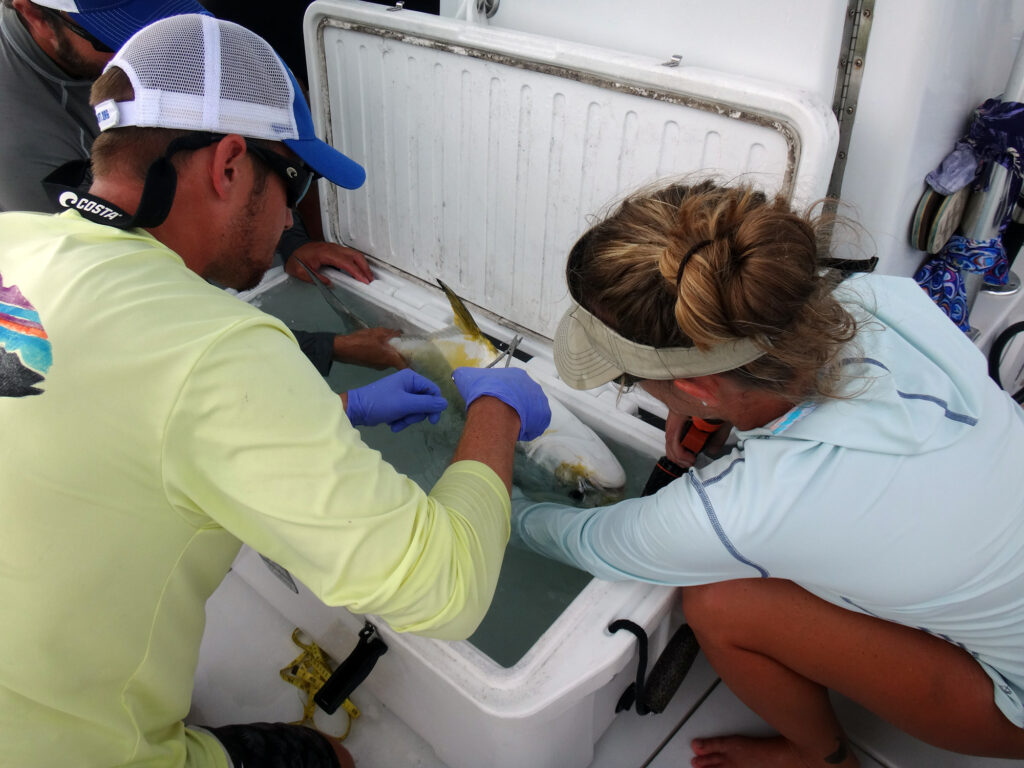
A permit swimming on a flat shallow enough to expose its black scythe-like tail certainly doesn’t seem “jack-like dumb” to fly fishers who suffer through countless fly presentations without a payoff. The most jaded fly fishers personify them, and call them [bleeping] dishonest, compared to tarpon, and maybe, bonefish. But a bait fisher who strictly plies offshore wrecks for permit loves that they act like jacks, more times than not. And yes, they are the same fish — revered wherever they’re pursued and caught.
Though far fewer Florida and visiting anglers target permit than they do tarpon, bones, redfish and others, the fish’s popularity is growing, as is the concern for their numbers and habitat. For starters this premier gamefish, released as an unwritten rule by flats anglers, is also a decent food fish, so a number do end up in the fish box. Or, unfortunately, the jaws of sharks.
The Project Goal
Bonefish & Tarpon Trust (BTT) researchers want to know more about the permit’s life cycle, its migratory habits, spawning activities and the threats to its habitat and very existence. The innovative project was launched in 2011. At the time, the Lower Keys Guides Association and BTT voiced concerns to the Florida Fish & Wildife Conservation Commission (FWC) regarding declining numbers of permit on the flats. Their suspicion was that overfishing of permit spawning aggregations, such as those at Gulf and nearshore wrecks, was the likely culprit.
There was little hard data at that time to support the groups’ claims, and FWC made it clear that data had to be provided in the future if the commission was expected to take the issue to the public. That was the impetus to ramp up Project Permit.

Dr. Ross Boucek, BTT Florida Keys Initiative Manager, says permit were an especially “poor data species” when Project Permit was launched in 2011, incidentally, the same year that the FWC established the Special Permit Zone (SPZ) which includes Florida state and adjacent federal waters south of a line running due east from Cape Florida in the Atlantic, the waters of south Biscayne Bay, and south of a line near Cape Sable running due west through federal waters.
“Within the established Special Permit Zone, commercial take is prohibited,” said Boucek. “And adjacent to the SPZ we have the Pompano Endorsement Zone, sharing a boundary with the SPZ. So there is allowance for gillnetters that hold a pompano endorsement license to take an unlimited number of pompano.” The two species frequent the same waters there, so the state allows an incidental bycatch of up to 100 legal-size permit. Unfortunately, this commercial harvest exists very close to the permit spawning grounds.
“We closely monitor long-term trends,” said Boucek. “I feel the commercial bycatch numbers are
sustainable, especially in the SPZ bordering the pompano endorsement zone. But on the Gulf
wrecks that attract permit aggregations we did some sentinel studies that revealed a concerning
number of hooked permit are eaten by sharks, which is a problem in other Florida fisheries.”
Permit Travels

Can permit be considered homebodies?
When asked about the possibility that permit travel from the Lower Keys as far north as Florida’s Atlantic Treasure Coast beaches or the Indian River Lagoon, where anglers catch them mixed in with pompano, Boucek said that’s not at all likely.
“First of all, the mixing in with pompano in that region is a big information gap,” said Boucek. “But we are very sure that permit we catch and tag here in SPZ waters of the Lower Keys do not make the jump north across the SPZ boundary in South Biscayne Bay. We have tracked thousands of acoustically tagged fish to prove that. These fish are not as migratory as tarpon,” said Boucek.
“A prime example of restricted migratory behavior is a permit that I and colleagues from Canada tagged nearly 5 years ago in the Lower Keys. We used both an acoustic transmitter and an external dart tag on that fish, the dart being the external type of tag our fishing guide volunteers use. Three years after the tagging, Keys guides Nathaniel Linville and John O’Hearn caught that fish only 100 feet from where we originally tagged it! Granted, it did move around the region quite a bit in those years, but it never left the general region.”
A Downward Permit Trend
Besides hard science data derived from tagging, Boucek credits detailed anecdotal information, provided by anglers and experienced permit guides, with helping BTT better understand the fish’s habits.
“Capt. Pat Bracher, out of Cudjoe Key, keeps the most meticulous catch records I’ve seen which he has shared with us. In fact his notes on declining barracuda catches provided Florida fishery managers with evidence compelling enough to tighten barracuda harvest regulations,” said Boucek. “Bracher prides himself on getting his flats clients a Grand Slam. And he has literally thousands of them to his credit. His fishing trip journal, which he shared with BTT shows an unmistakable downward trend for permit around Key West, which started in the early to middle 2000s. The trend became apparent in the Lower Keys a bit more recently.”
Threats to Permit Numbers

Other than allowances for some commercial harvest, it’s become apparent that recreational harvest puts a dent in the permit stocks as well. Among light-tackle and fly anglers who enjoy sight fishing the flats for them, release mortality is low. Education and improved catch-and-release techniques, including minimal time out of the water, has helped immensely.
Ross Boucek hopes that anglers of all persuasions better appreciate the permit for its fighting ability, even on nearshore wrecks.
“We get the fact that this species is a legal fish for the table, but we think there is excitement to catching a big permit over a wreck, and satisfaction in releasing them. If the angler’s ultimate goal is to kill a fish for the table, that’s fine too,” said Boucek.
On the subject of shark depredation, Bouchek cited BTT’s studies of that situation on a few sentinel wrecks in the Gulf and some sentinel spawning sites on the Atlantic side of the Keys that hold flats permit.
“We found that about 35 percent of hooked permit are killed by sharks on Western Dry Rocks, out of Key West, and that has been a consistent number before and even after the closure period (April 1 through July 31),” said Boucek.
And the numbers are even greater (up to 80 percent of hooked permit killed) on some Keys Gulf wrecks and those in Florida Bay just outside the Everglades National Park boundary. The BTT feels these are not sustainable numbers. In light of these troubling numbers, which are anecdotal according to BTT, researchers are not sure whether anglers after permit (or snapper species) are changing their behavior by avoiding “sharky” wrecks or not.








